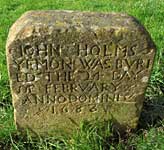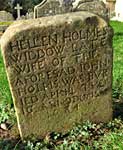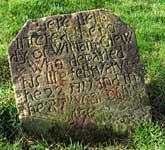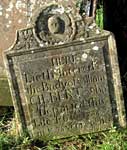 Upton Upton
St Peter and St Paul
Churchyard
The churchyard is broadly rectangular in shape. The church is situated to the north, with the majority of the graves lying to the south of it. The two principal entrances are to the NW and NE with a paved path running between them to the north of the church. A public footpath crosses the churchyard from north to south at its west end. This is part of the Trent Valley Way.
The majority of the churchyard is now closed for burial and is managed by Newark and Sherwood District Council. The only part of the churchyard still managed by the church is a recent extension to the south-east, which is still used for burials.
Most of the older graves, which are located close to the church, especially to the east and south-east, are now illegible. Keith Train, visiting in the 1960s, found a grave dated 1605 which had sunk into the ground – this is probably the oldest grave in the churchyard. Train also noted the gravestone of a Jane Bettinson dated 1702. F. H. West in the 1940s noted ‘a row of crude stones over the graves of John Holmes, his wife and their three sons who all died in 1683 within a few weeks of each other.’
 Grave marker for John Holmes (1683) Grave marker for John Holmes (1683) |
 Grave marker for Helen Holmes (1684) Grave marker for Helen Holmes (1684) |
 Grave marker for William Glew (1717) Grave marker for William Glew (1717) |
 Grave marker for William Gilbert (1744) Grave marker for William Gilbert (1744) |
There are many graves dated 1800 – 1850 to the south side of the church. The graves seem to have been set out almost in concentric circles such that the oldest graves are closest to the church and the newer ones further away on all sides.
Among those buried in the churchyard is William Henry Smith, one of the ten men of Upton who died in WWI, and who was given a military funeral in recognition of his bravery as a stretcher-bearer at Gallipoli.
To the north of the church is a vault containing the remains of Elizabeth Milnes, who died in 1845 aged 26 and was wife of the Rev. Frederick William Naylor, vicar during the mid-19th century. Naylor himself is buried in a vault by the north porch.
Train made a list of over 30 gravestone inscriptions, which can be found in the Diocesan Archives.
|